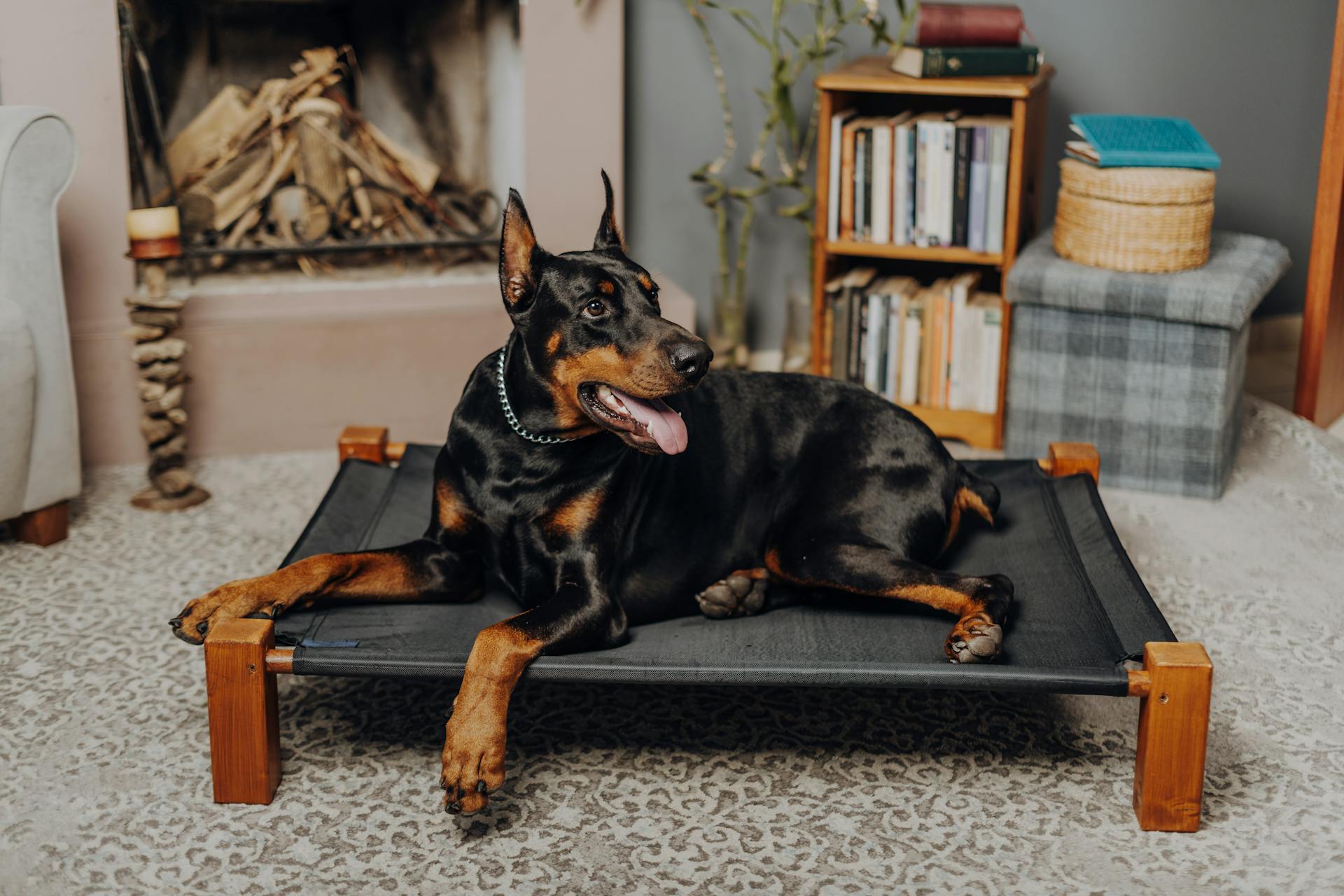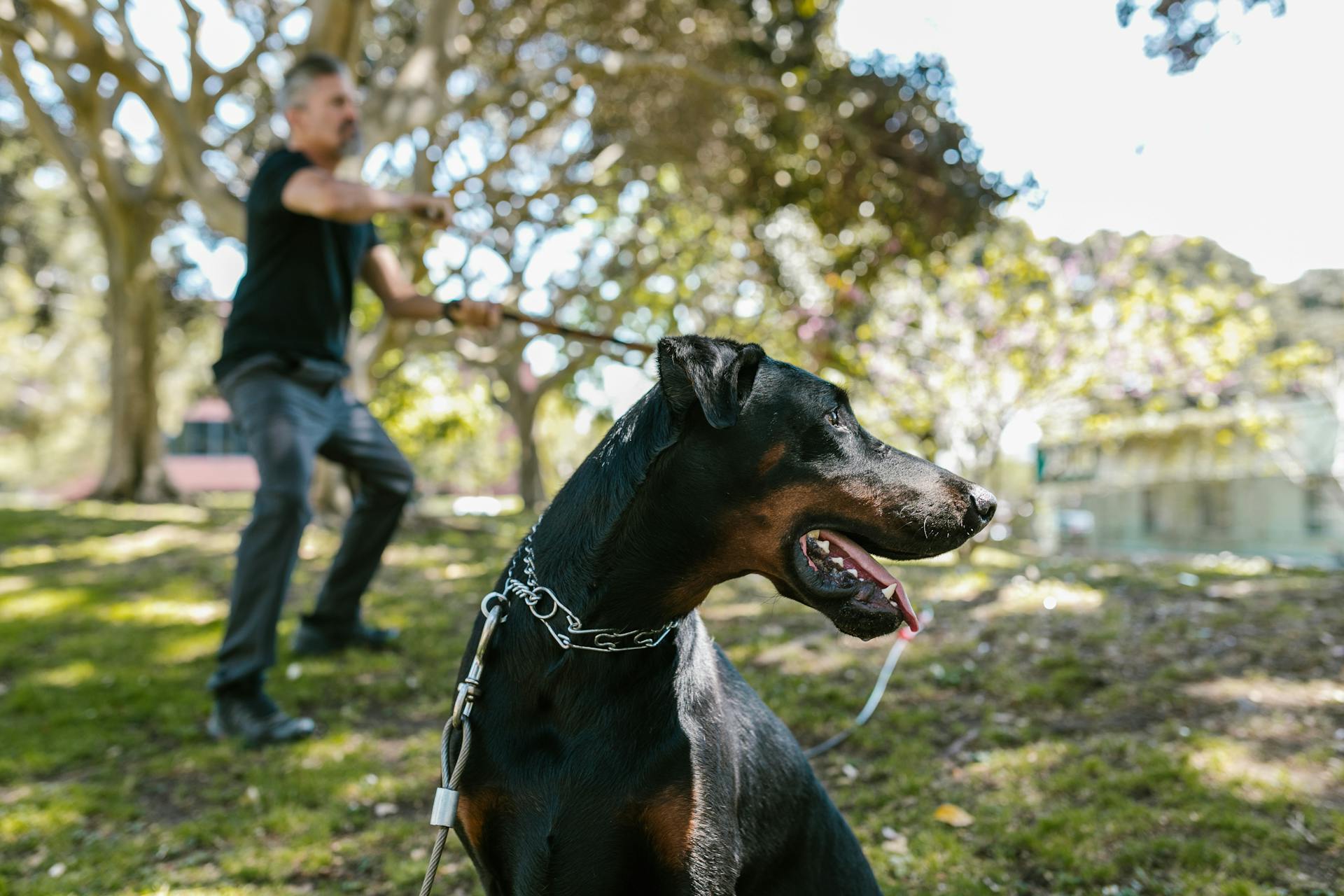
The Doberman Pinscher is a versatile breed with several distinct types. The most common type is the Standard Doberman, which is the original breed developed by Friedrich Louis Dobermann in the late 19th century.
The Standard Doberman is known for its muscular build, athletic ability, and short, smooth coat. They typically weigh between 60-80 pounds and stand between 24-28 inches tall at the shoulder.
The Doberman Pinscher's intelligence and trainability make it a popular breed for police and military work. With proper training, they can excel in a variety of roles, from search and rescue to guarding and protection.
The breed's athleticism and agility also make it well-suited for competitive dog sports, such as agility and obedience training.
Check this out: Pembroke Welsh Corgi Agility
Care and Maintenance
Doberman Pinschers are relatively low-maintenance when it comes to grooming, requiring only a weekly brushing and baths as needed.
Their short coats make it easy to keep them clean and tidy. Give them a good brushing once a week to keep their coat healthy and shiny.
To keep your Doberman Pinscher's teeth, nails, and ears in good condition, regular care is essential.
Make sure to schedule regular dental check-ups and brush their teeth daily to prevent tartar buildup.
A Doberman Pinscher needs plenty of exercise to stay happy and healthy, so be prepared to take them on daily walks, runs, or hikes.
A fenced space is a must to prevent them from getting into trouble or running off during their zoomies.
Consistent training is crucial for Doberman Pinscher puppies, and working with a professional trainer or behaviorist can be incredibly helpful.
With their high intelligence and love of learning, Doberman Pinschers can quickly pick up tricks and commands with positive reinforcement training.
A different take: Obedience Training for Doberman Pinscher
Health and History
The Doberman pinscher is a breed with a rich history and a unique set of characteristics. The average lifespan of a Doberman is 10 to 12 years, and they can be prone to certain health issues.
Hip dysplasia is a common concern for Dobermans, and their heart and thyroid health should be checked regularly. Bloat is another gastrointestinal issue that can occur at any point in a dog's lifetime and carries a 50% mortality rate.
Dobermans have a fascinating history that dates back to the 1880s with Louis Dobermann, a tax collector and breeder from Germany. The breed was created by mixing different dog breeds to produce a strong, intelligent, and energetic dog.
For another approach, see: Are Rottweilers and Dobermans Related
Health
The average Doberman lifespan is 10 to 12 years, but health issues can affect their quality of life.
Hip dysplasia is one of the most common health issues Dobies deal with, according to the DPCA.
Bloat is another major concern for Doberman owners, with a 50% mortality rate if left untreated.
Doberman owners should educate themselves on the symptoms of bloat and talk to their veterinarian about ways to help prevent it.
Von Willebrand's disease can also be a problem, especially as Dobermans get older, causing issues with blood clotting.
To ensure you're getting a healthy Doberman, request all health information available from the breeder or adopter, and have them complete all recommended health testing by the OFA.
Related reading: Are Portuguese Water Dogs Good for First Time Owners
History
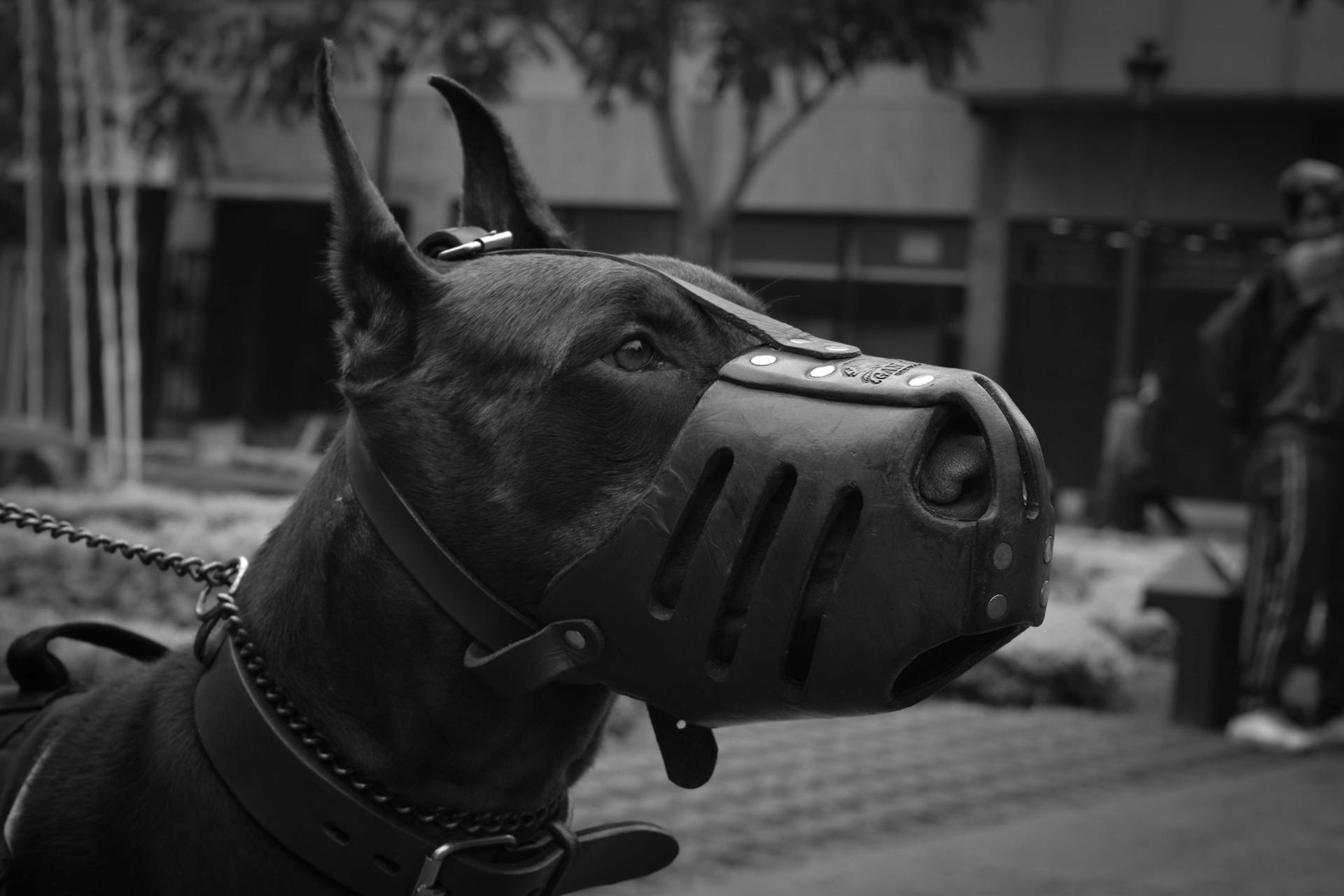
The Doberman Pinscher has a fascinating history that spans over a century. The breed was created in the 1880s by Louis Dobermann, a tax collector and breeder from Germany.
Dobermann wanted to create a dog that would serve as a loyal watchdog, so he began mixing different breeds to achieve the perfect combination of strength, stamina, and intelligence. Two German breeds, the old German shepherd and the German pinscher, played a major role in the breed's development.
These two breeds are also thought to be the ancestors of the Rottweiler and the Weimaraner, making the Doberman Pinscher's heritage quite impressive. The breed was initially called the Dobermann-pinscher, but the "pinscher" part was dropped in the 1940s.
The Doberman Pinscher was recognized by the American Kennel Club in 1908 and quickly became a popular breed in the United States. Today, the breed is still one of the most popular in the country.
Related reading: Most Famous Breeds of Dogs
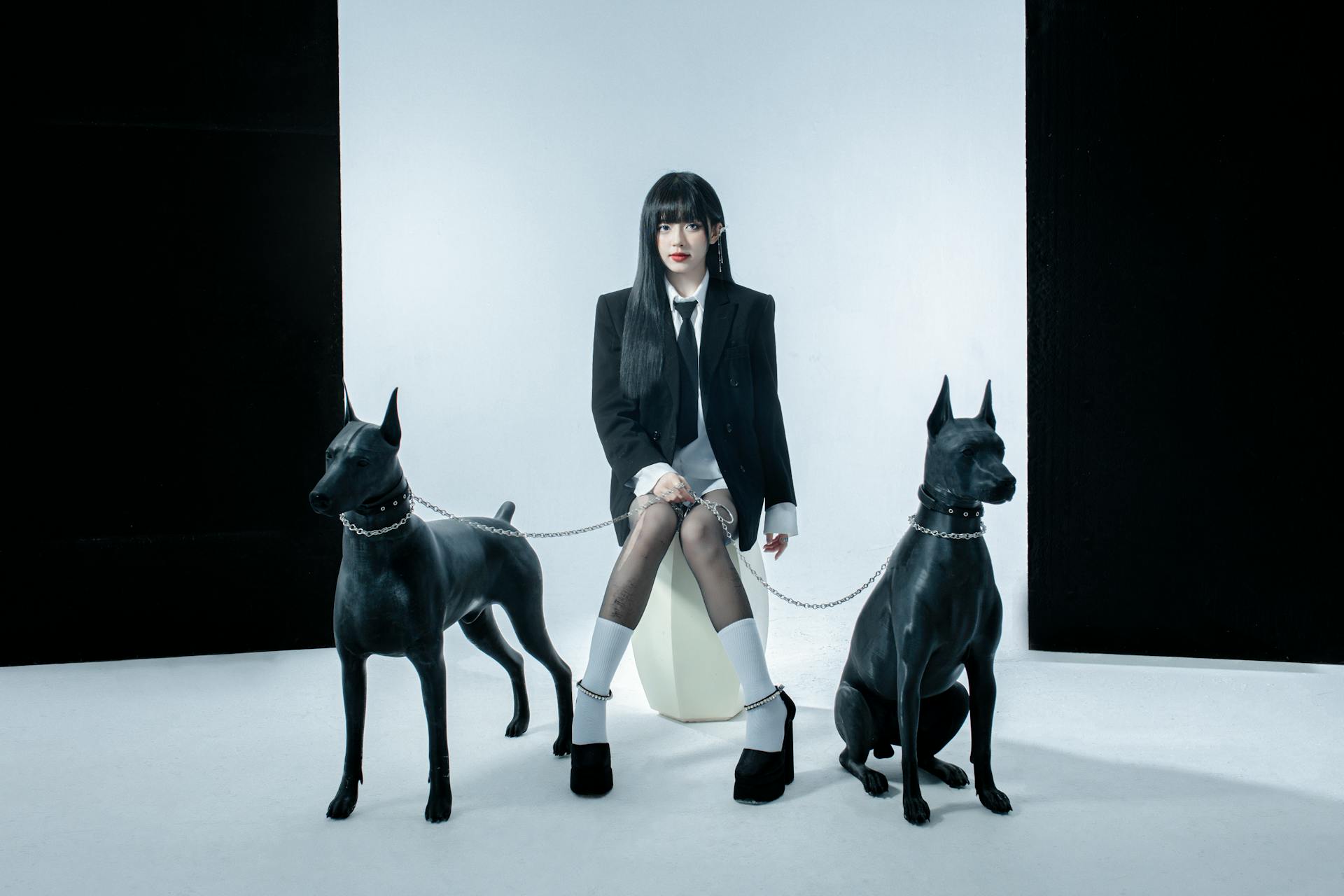
The Doberman Pinscher's history is closely tied to its use as a military and police dog. The breed was used extensively in World War II, serving as sentries, messengers, and scouts. A memorial statue of a Doberman Pinscher stands in Guam to commemorate the 25 marine war dogs that gave their lives during the war.
Physical Characteristics
The Doberman Pinscher's physical characteristics are truly unique and attractive. They have a square-bodied, smoothly-muscled build with a short coat.
Their heads are wedge-shaped with high-set ears that may be cropped or hang naturally, and their naturally arched neck flows into smooth shoulders.
Their strong, straight topline continues on to the tail, which appears to be a continuation of the spine. The length of the head, neck, and legs are in proportion to the length and depth of the body.
Their short, smooth, glossy fur accentuates their strong build, and their almond-shaped eyes typically have an alert and energetic expression.
They come in four colors with rust markings: black, red, blue, and fawn.
Expand your knowledge: How Strong Are German Shepherds
General Appearance
The Doberman Pinscher's sleek and smooth coat lies close to the skin and comes in four colors: black, red, blue, and fawn, often with rust markings on specific areas.
Their short coat sheds, but weekly brushing with a grooming mitt or rubber curry is usually sufficient to keep them looking their best.
Their head is wedge-shaped with a flatter skull than most breeds, and their almond-shaped eyes are typically alert and energetic.
The Doberman Pinscher's iconic look has triangular ears that are carried erect, but they're actually born with long tails that have a tendency to curl up, and hanging ears.
Their natural tail is often cropped when they're still young, usually between seven and twelve weeks old, to achieve the breed standard for the American Kennel Club.
Their four recognized colors are all sporting distinctive rust-colored markings on their face, chest, and legs.
In rare cases, a Doberman Pinscher may be born albino, a pale cream color referred to as white, or even all black with no tan markings.
Additional reading: Doberman Pinscher Markings
Size
Doberman Pinschers come in a range of sizes, with males typically standing between 26 to 28 inches tall at the shoulder.
Males are generally more robust and imposing than females, who stand slightly shorter at 24 to 26 inches tall.
Both males and females weigh between 60 to 80 pounds, but males tend to be slightly larger and heavier.
Their well-muscled and athletic build contributes to the Doberman's overall strength and agility.
These size variations are essential to consider when choosing a Doberman as a family companion or working dog, depending on individual preferences and lifestyle requirements.
Take a look at this: Dogs Breeds That Start with B
Characteristics
Doberman Pinschers are known for their striking appearance, but what makes them tick? Let's dive into their characteristics.
Doberman Pinschers originated in Germany, and their size can vary from 60 to 100 pounds, with a short, smooth coat that comes in four recognized colors: black, red, blue, and fawn.
They're a part of the Working Group, and their lifespan is around 10 to 13 years. Their temperament is intelligent, loyal, and alert, making them a popular choice as family pets.
Doberman Pinschers are highly trainable and eager to please, but they do require regular exercise and mental stimulation to prevent boredom and destructive behavior.
Here are some key characteristics of the breed:
- Origin: Germany
- Size: 60 to 100 pounds
- Coat: Short, smooth
- Colors: Black, red, blue, and fawn
- Lifespan: 10 to 13 years
- Temperament: Intelligent, loyal, and alert
- Exercise Needs: High
- Training: Highly trainable
Overall, Doberman Pinschers make great companions for active families, but they do require consistent training and exercise to thrive.
Family and Lifestyle
Doberman Pinschers are a great addition to families who are willing to put in the time and effort to train and socialize them. They thrive on attention and positive reinforcement training from their family, and consistency in their schedule is key.
Dobies are known as "Velcro dogs" because of their strong bond with their family, which can sometimes lead to separation anxiety if left alone for too long. Preparing them to be comfortable while alone at home is crucial, and creating safe spaces in your house can help.
Kennel training is essential for Doberman Pinschers, especially with puppies, to help them feel secure and relaxed when you're not around. A well-fitted kennel that's introduced gradually can be a lifesaver for this active breed.
Explore further: Welsh Corgi Training
Personality
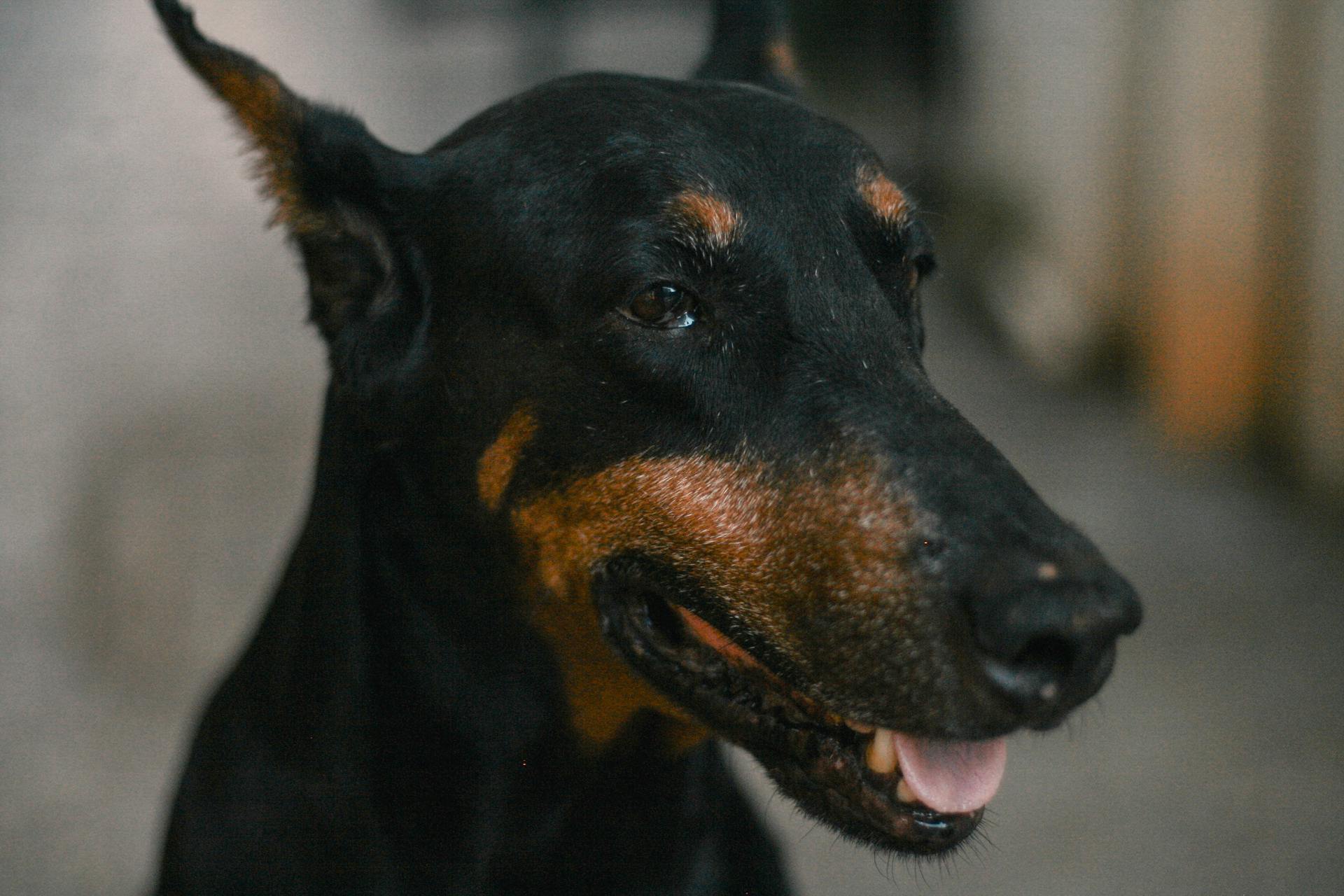
Dobermans are highly intelligent and deeply loyal canines that thrive on attention and positive reinforcement training from their family.
They require consistency in their schedule and can develop separation anxiety if left alone for too long, making it essential to prepare and plan ahead to prevent this issue.
Dobermans are natural protectors and will act promptly if they perceive a threat to their loved ones, but they don't display aggression without cause.
Their unique personality trait is their extended period of puppy-like behavior, lasting until they are three to four years old, which is influenced by genetics, training, and socialization.
Early socialization is vital for Dobermans, involving exposure to diverse people, environments, and experiences during their formative months to ensure they mature into well-rounded and well-behaved dogs.
Dobermans can become trustworthy and gentle companions towards children if they have been trained and socialized appropriately, and teaching kids how to approach and interact with the dog in a respectful and kind manner is crucial for a safe and harmonious relationship.
Proper socialization and training can help Dobermans become more accepting of other canines outside their family circle, ensuring peaceful interactions in various environments.
By investing time and effort in training, socialization, and responsible pet ownership, families can enjoy a wonderful and rewarding relationship with their Doberman.
Living Needs
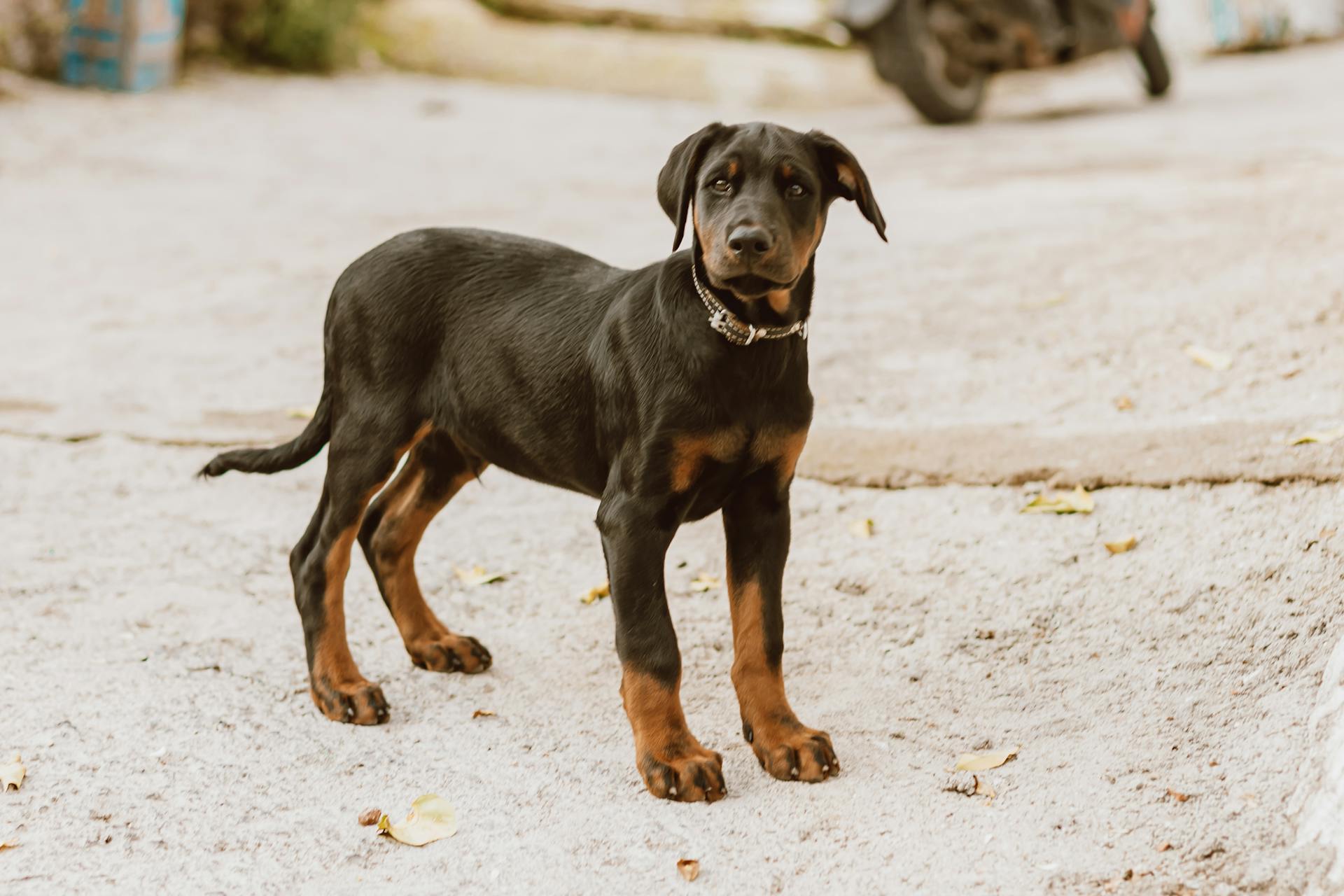
Living with a Doberman requires some careful consideration of their needs. They're not couch potatoes, so they need daily mental and physical enrichment.
A good run or a vigorous game of fetch is a great way to keep them happy and exercised. They also love to participate in training classes, agility, nose work, or flyball competitions.
Dobies can do well with other dogs and even cats if they're socialized properly and introduced at a young age. They're generally great with other pets if they're raised right.
Their energetic personality means they can accidentally knock down small children, so it's best to avoid homes with little ones. They can also be startled by kids' loud noises.
A fenced-in backyard is ideal for a Doberman, but they can adapt to apartment life if their needs are met. They just need a lot of attention and exercise to stay happy and healthy.
Broaden your view: Dog Breeds That Don't Need Grooming
Comparison and Recommendations
The Doberman Pinscher is a versatile breed with four main types: the Standard, the Miniature, the Dobermann, and the European. The Standard Doberman Pinscher is the most common type, weighing between 60-80 pounds.
The Miniature Doberman Pinscher is significantly smaller, weighing around 20-30 pounds, but still retains the breed's distinctive features. With proper training, Miniature Dobermans can make excellent companions for apartment dwellers.
The Dobermann is a rare type of Doberman Pinscher, known for its muscular build and athletic ability. Its short, smooth coat requires minimal grooming.
European Dobermans are characterized by their sleek, athletic build and wedge-shaped head. They are highly intelligent and responsive to training, making them a popular choice for working roles.
Frequently Asked Questions
What is the best breed of Doberman?
There is no single "best" breed of Doberman, as the ideal choice depends on the owner's lifestyle and preferences. American male and European female Dobermans excel in different roles, making them suitable for various households and owners.
Is there a difference between Doberman and Doberman Pinscher?
Yes, there is a difference in naming conventions between regions, with 'Doberman' used outside North America and 'Doberman Pinscher' used in the US and Canada
Are American or European Dobermans better?
European Dobermans are generally considered more stable and reliable, making them a popular choice for families seeking a protective companion. However, both American and European Dobermans can excel as guard dogs with proper training and temperament.
How to tell the difference between American and European Doberman?
To identify a European Doberman, look for a slightly larger and more muscular build, particularly a broader chest. This distinctive physique is a result of being bred to the FCI's breed standards.
What is the rarest Doberman Pinscher?
The rarest Doberman Pinscher is the Fawn and Rust (or "Isabella") Doberman, making up only a small percentage of the breed. This unique color combination is highly sought after, but relatively rare.
Featured Images: pexels.com
